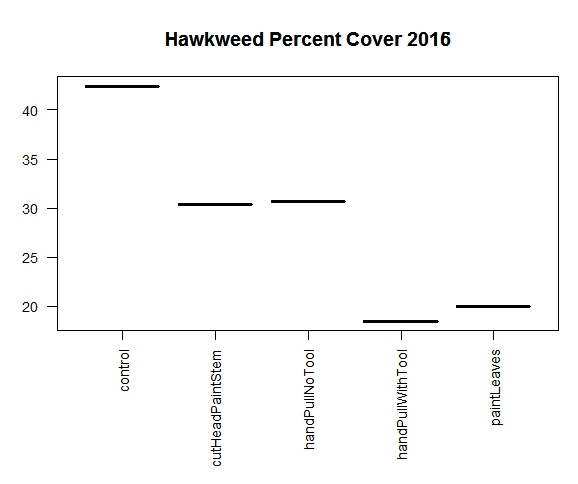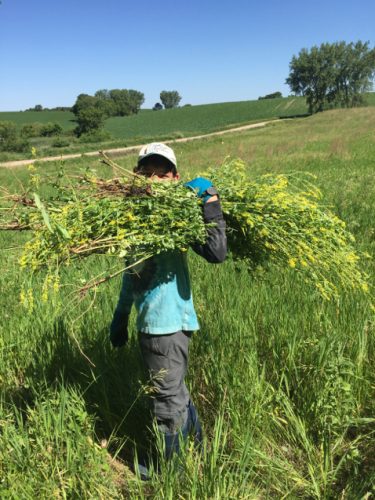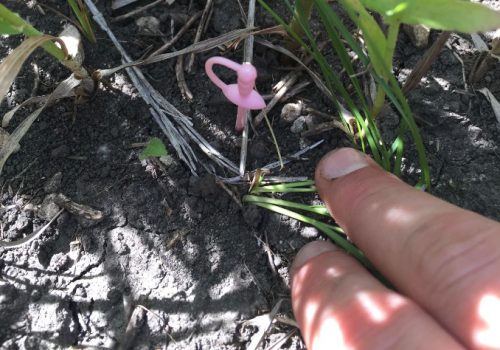|
|
Last Friday, I was dispatched by Stuart to find the number of plants/ achenes planted in each experimental plot, along with the number alive as of a recent year (2017-2019, based on the plot). Although records of some plots were a bit harder to come across that others, I was able to compile data from each plot (besides p10 – planted 2019 – data coming soon). This would not have been possible without the help of Gretel, so thanks GK! I have attached a small datasheet with the survival data.
In the history of the Echinacea Project, the team has sown 31,888 Echinacea viable achenes in experimental plots. There were many more sown that likely did not have a seed. Team members found 3634 seedlings from these seeds, not including Amy D’s experimental plot 3 and remnant seedling refinds. The team has planted 18,869 Echinacea seedlings in experimental plots, not including p10 – planted at West Central Area HS in 2019. Finally, 7090 Echinacea are currently alive in the experimental plots!
It’s raining. We searched for sweet clover south of p1 (experimental plot 1) and pulled about 70 stems. We started walking through p1 and encountered three clumps of bird’s-foot trefoil in rows 31 & 32 near position 878. As we were extracting the three bad plants with garden knives, the skies unleashed a downpour. We hastily gathered the leguminous carnage and headed back to the Hjelm house.
In 2014, members of Team Echinacea did an experiment to test methods of removing Hawkweed. Last year Ali assessed the results of the different methods that they used: cutting the head and painting the stem with herbicide, painting the leaves with herbicide, hand pulling with and without tools, and a control treatment. You can read her post describing the experiment and with the results from 2015 update here and the original post with methods here.
I went back to the treatment plots this morning and assessed Hawkweed percent cover two years after the treatment. The plots with the lowest percent cover this year were those where they removed hawkweed by hand, with tools. These plots also had the smallest percent change from 2015 to 2016, indicating lasting effects of removal. This was in contrast to those that had been treated by painting leaves with herbicide, where plots had an average of 4x increase in Hawkweed. From now on, we’ll use this method to remove Hawkweed in P1. We’ll assess percent cover in the treatment plots and the status of other Hawkweed plants in p1 to keep track of our progress at eradicating Hawkweed from the common garden.
Here’s the percent cover data from this year:
hawkweedData2016

The gang had a busy day today, almost all of it in the warm June sun. Alyson continued setting up her experimental plots in the Staffanson bog, and spent the afternoon measuring canopy cover and soil pH for her IS project. Meanwhile, the rest of the team (minus Gretel, who was setting up work for q2 juvenile counts) picked up our fleg begs and counted Hesperostipa spartea and weeded in p1. Amy and James found one H. spartea specimen with 137 seeds! We are now up to 17 out of 59 rows surveyed. Meanwhile, Will, Alex and Per led the crew in weeding out the non-native yellow sweet clover (Melilotus) from the periphery of the plot area. Hopefully we eliminated a lot of potential seeds form the seed bank, meaning that in future years the rows will be devoid of this weedy legume and the study Echinacea will have less competition. Stuart also showed me what poison ivy looks like for the third time, and I still don’t think I could pick it out of a lineup.
 Per with a bundle of sweet clover picked from around p1. This is probably less than 10% of what was removed today. After some brief (or for Alex, who was cleaning the bathroom, not so brief) chores at the Hjelm House, the team returned to exPt8 (experimental plot 8) to search for juvenile Echinacea crosses planted in 2013. This meant more time bent over, although now instead of looking for seedlings we were looking for melted bits of toothpick (which were placed to mark seedlings). Some seedlings were in great shape — Alex and I found a couple with basal leaves over 10 cm tall. Others were not in great shape, either dead or missing like Jimmy Hoffa. We got about a third of the work for qGen2 this afternoon. It may rain tomorrow, so we’re bracing for indoors-work and hiding our bicycles inside.
 Using a pink sword to claim the new seedling (left) for Team Echinacea. We used cocktail swords to denote seedlings germinating this year from achenes sown in 2013.
Team Echinacea is currently trying to find a data collection system to replace our old trusty Visors. Interestingly enough, the problem isn’t with the visors themselves, nor with the forms system we’re using (an old version of Pendragon Forms), but with the computer that has our version of Pendragon. It’s an old version so we can’t get a copy for another computer, and the computer isn’t going to make it much longer. We have some temporary fixes in mind (more to come on that) but we’re looking for a long term replacement for our lovable, early-2000s technology. We posted a question to Ecolog and in the past week we have received several responses. Here’s a summary of the findings in case you can’t make it to Ecolog this week:
- A Nexus 7 with Google Sheets for data collection. A cheap mobile data plan allows for data syncing throughout the day. A case that has a wrist strap so it’s more portable and a portable battery to help with battery life. Cost $350 at time of purchase.
- Samsung Tab4 tablets (refurbished from Amazon) and an external Garmin GPS that connects via Bluetooth. Data collection is done with open data kit and the ODKCollect app for Android
- iPad mini using the Numbers app to collect data. The important thing is not to use a big case, apparently an Otterbox can cause overheating quite quickly in direct sunlight.
- Using an HP Stream 7 tablet running windows with MS Access for data entry. The main problems were screen glare, even when using an anti-glare cover, and buttons being too small on forms. Overall: not recommended
- Small field laptops (Panasonic Toughbooks) with Real Time Research Field Forms
In brief:
The hardware: Nexus 7, Samsung Tab4, iPad mini, HP Stream 7, and Panasonic Toughbooks
The software: Google Sheets/Forms, Open Data Kit, Numbers app, Fulcrum app, EpiCollect, Pendragon Forms, MS Access, Real Time Research (RTR) Field Forms
We were surprised to see that no responses from people using phones for data collection, so if you are using phones, we’d like to hear from you. Right now, we’re not sure exactly which direction we’ll take but the software options we’re leaning towards are Open Data Kit and Pendragon Forms. Our team intends to do a trial run in the upcoming field season and deploy as many as 15 devices starting in June. We’re going to be giving updates in our blog, so follow along at echinaceaProject.org/datacollectionsystem. We set up comments on our website so if you have any suggestions, thoughts, or words of encouragement, stop by our website and let us know.
Today we started in P8 by pulling some sweet clover. It was not a task to be taken lightly, only the heartiest could master the “full pull.” It was really in the ground and being held tight by Brome grass. We did manage to pull on and get a lot pulled out and removed. Hopefully there will be a lot less in the plot from now on. Below is a picture of our bundles. We figured they were at least as big or bigger than Gina! We broke for lunch and then started flagging in P1 and at Hegg lake. We were all getting quite good at finding plants and/or staples and almost had all the 5 meter flagging done when a sudden, unexpected rain shower left us running for cover!


Wednesday
- SW & JB arrived Wednesday evening (May 20)
- SW and JB walked burn breaks and developed plan
Thursday
- WR and JB mowed break around North field and South field of P1
- WR and JB started clearing break for southeast hill
- SW drove to Alexandria and picked up Bush Hog
- SW, JB, and WR prepared equipment for burning
- Ignition time just after 1pm
- Burn crew: WR, SW, JB, Brad, Amy, Joyce, and Jean
- Started in the southwest corner of P1 and continued to the southeast corner
- Backfire through south 1/3 of common garden
- Wind was N-NW, fairly consistent 10-15mph
- SW downloaded weather history for Alex and Elbow Lake, these forecasts accurately reflected the conditions
- Burn in P1 was slow but thorough, walking path on the south end did not burn well
- Patch east of the southeast corner of common garden also did not burn well
- 2 piles burned in the hedge row on the east side, these piles burned for hours
- We did not burn the entire south field of P1 because of time constraints but we completed a small burn around 99S, very complete burn
- We burned Jean’s garden (just north of 99S)
- We then drove to Holmes City and burned Joyce’s 10 acre restoration
- Dwight and Matt joined the burn crew for this burn
- Burn went well but it would have been good to have burn breaks, simply mowing a strip around field would be helpful

Friday
- JB and WR planted some E. angustifolia and E. pallida from Ian’s competition experiment on the south side of the Hjelm House (~30 planted)
- JB and WR prepared burn breaks for SE hill, cut path through woods
- Winds were light and variable until 1pm so we did not burn
- Found Viola pedatifida flowering on SE hill just uphill from ephemeral pond, also a few plants flowering in path on top of savannah hills
- WR and JB visited SPP to investigate problem akas cg00 and as03 for demap
- Flowering plants included Commandra, Pedicularis, Zizia aptera, Geum triflorum, Lithospermum canascens, Anemone patens (seeding), Viola pedatifida, Sisyrinchium, and Astragalus crassicarpus
- SW and JB put out smoldering piles in P1
- Visited Hegg Lake WMA during burn, fire looks great!
- Burn at P2 was thorough, some paths between rows evident but partially burned, one patch of Antennaria at west end of P2 was unburned
- JB broadcast seed in P1:
- Bouteloua curtipendula, Schizachyrium scoparium, and Galium boreale in common garden experimental plot
- Onosmodium, Dalea purpurea, Hieracium, Zigadenus, Potentilla arguta, Carex spp. and Heuchera in ditch
- SW broadcast Bouteloua, Schizachyrium, and Galium in P2 at Hegg. All seed was collected from Hegg WMA in fall 2014.
- Oxytropis was broadcast in southwest corner of P2

Dwight and Stuart broadcast native prairie seed in experimental plots p1 & p8 on Friday. At 34 °F (1°C) it was the warmest day in a month. It was also very windy –great for spreading seed! We broadcast Bouteloua curtipedula, Schizachyrium scoparium, Galium boreale, and Phlox pilosa directly on the snow. There wasn’t much snow and it was melting. We broadcast Lathyrus venosus in p1. We stored about half of each species, except L. venosus, in the Hjelm house to broadcast in the spring. (Hedging our bets.)
These are the methods for the hawkweed removal experiment performed by Allison Grecco, Cam Shorb, Jared Beck and Elizabeth Mays in experimental plot 1. The percent basal cover of hawkweed in each quadrant is to be determined by Team Echinacea in Summer 2015.
Hawkweedremovalmethods.pdf
… to pull weeds, that is! Today Jared, Allie, Cam and I designed an experiment to determine the most effective and efficient way to terminate hawkweed from the SW corner of Experimental Plot 1 (P1). We created a 4m x 4m plot with 16, 1m quadrants. We originally wanted to have four treatments of: 1. Hand weeding 2. Hand weeding with tool 3. Painting round-up solution on peduncles after cutting off the flowering heads 4. Painting round-up on one leaf per basal rosette. Due to time restraints we had a fifth treatment: 5. No hawkweed removal (as a control). We learned a lot about experimental design while getting our hands dirty! In the afternoon we removed the rest of the hawkweed that was outside the plot and searched multiple rows in P1 for Stipa, affectionately known as “Porcupine Grass”. At least it’s not as smelly as the porcupines in the Colorado Springs Zoo! (Title of flog post inspiration courtesy of Rebecca Blacks infamous song “Friday”.)
|
|







